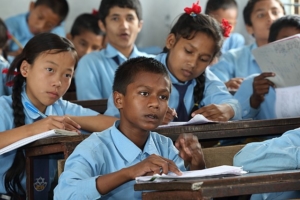UN Education Fund Sees Success in 2021 Report

Around the world, 222 million children and adolescents are currently experiencing conflict and crises. Of those children, 78.2 million are unable to attend school and 119.6 million face barriers to an adequate education. The findings come from the United Nations’ education fund in crisis-impacted countries, Education Cannot Wait, in its 2021 report.
Education Cannot Wait is the U.N.’s first global fund for “education in emergencies and protracted crises.” The fund underwent establishment in 2016 at the World Humanitarian Summit and aims to ensure that every child can attain an education, regardless of their circumstances.
Despite global challenges, ECW found many successes in 2021, from increased funding to the number of children it was able to serve with its programs. Titled “We Have Promises to Keep,” the 2021 report highlights the fund’s record highs in education grants and mobilization as well as improved gender parity in its educational programs.
Findings
- Forcible displacement due to conflict or disaster presents the main barrier to education. Children and adolescents have disproportionate representation among internally displaced, refugee and returnee populations. A little under half of the 89.3 million internally displaced people in 2021 were under the age of 18, which had a significant impact on their access to education. Child refugees may not be able to enroll in school within temporary accommodations or host communities, or they face financial pressure to work and support their families. The increasing trend in displacement has only continued. As of May 2022, there were more than 100 million displaced people, a record-breaking number according to the U.N. High Commissioner for Refugees.
- Changing weather patterns remains one of the primary causes of displacement and its impact on education. Natural disasters drove the most displacement in 2021 and around 40 million children have disruptions in education because of extreme weather. Climate-driven poverty and malnutrition are also becoming a large concern for children, especially in South American and African countries.
- Attacks and military presence in schools have increased, especially in crisis-impacted countries. There were 2,100 attacks on education in 2021, which was a 33% increase from 2019. Moreover, girls were subject to gender-based attacks in at least 11 countries.
- The COVID-19 pandemic has exacerbated the issues mentioned above. Low and middle-income countries have been slow to reopen schools, and 42 countries still had partial closures and six countries had fully closed schools as of July 2022. The countries also face challenges in implementing remote learning due to the lack of widespread technology access. This disproportionately affects girls, as the report points out the “digital gender divide.”
Successes
- According to the 2021 report, ECW raised $388.6 million in funding in 2021 and mobilized a total of $1.07 billion since its establishment, which surpassed its initial targets.
- The fund supported 11.8 million children and adolescents through its COVID-19 interventions in 2021 alone, bringing the total number of children supported during the pandemic to 31.2 million, of which more than half were girls. A large share were children from internally displaced and refugee populations.
- It also provided textbooks and learning materials to more than 2 million children in 2021.
- ECW implemented programs in 32 countries with 174 grants, the majority of which were countries in severe crisis.
- The share of children reached for early childhood education increased from 5% in 2019 to 9% in 2021, and secondary education from 3% to 11% for the same period.
- About 92% of ECW programs reportedly achieved improved gender parity.
Looking Ahead
Education Cannot Wait’s “We Have Promises to Keep” report shows that even in the face of increased global challenges, significant progress can occur. Despite setbacks in the education sector, the fund broke records and targets set in 2016. However, keeping increasing trends in conflict and crises and their impact on education in mind, more work if necessary.
– Ramona Mukherji
Photo: Wikipedia Commons
